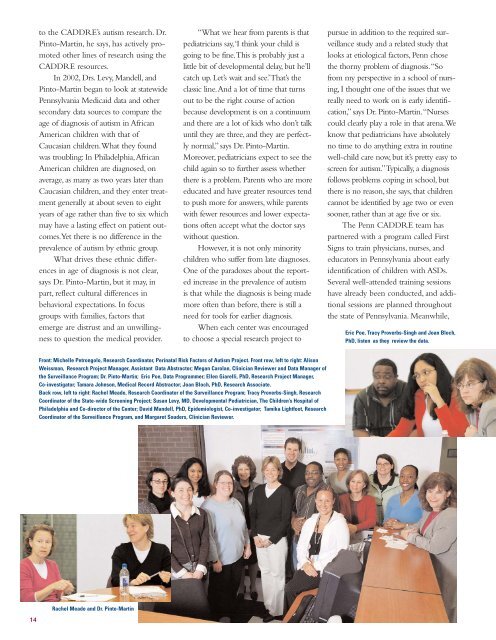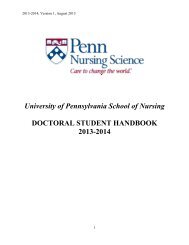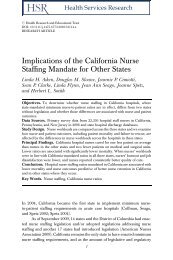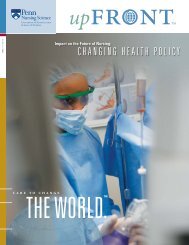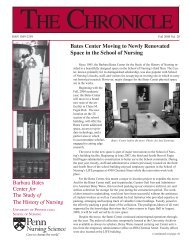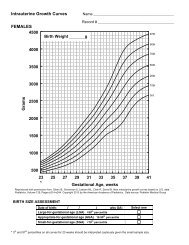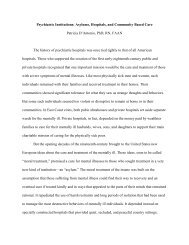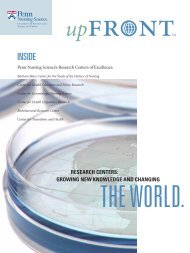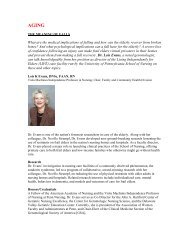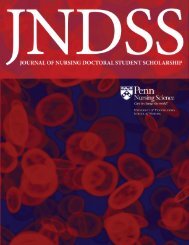Penn Nursing 090805_final_4c - University of Pennsylvania School ...
Penn Nursing 090805_final_4c - University of Pennsylvania School ...
Penn Nursing 090805_final_4c - University of Pennsylvania School ...
You also want an ePaper? Increase the reach of your titles
YUMPU automatically turns print PDFs into web optimized ePapers that Google loves.
to the CADDRE’s autism research. Dr.<br />
Pinto-Martin, he says, has actively promoted<br />
other lines <strong>of</strong> research using the<br />
CADDRE resources.<br />
In 2002, Drs. Levy, Mandell, and<br />
Pinto-Martin began to look at statewide<br />
<strong>Penn</strong>sylvania Medicaid data and other<br />
secondary data sources to compare the<br />
age <strong>of</strong> diagnosis <strong>of</strong> autism in African<br />
American children with that <strong>of</strong><br />
Caucasian children.What they found<br />
was troubling: In Philadelphia,African<br />
American children are diagnosed, on<br />
average, as many as two years later than<br />
Caucasian children, and they enter treatment<br />
generally at about seven to eight<br />
years <strong>of</strong> age rather than five to six which<br />
may have a lasting effect on patient outcomes.Yet<br />
there is no difference in the<br />
prevalence <strong>of</strong> autism by ethnic group.<br />
What drives these ethnic differences<br />
in age <strong>of</strong> diagnosis is not clear,<br />
says Dr. Pinto-Martin, but it may, in<br />
part, reflect cultural differences in<br />
behavioral expectations. In focus<br />
groups with families, factors that<br />
emerge are distrust and an unwillingness<br />
to question the medical provider.<br />
“What we hear from parents is that<br />
pediatricians say,‘I think your child is<br />
going to be fine.This is probably just a<br />
little bit <strong>of</strong> developmental delay, but he’ll<br />
catch up. Let’s wait and see.’That’s the<br />
classic line.And a lot <strong>of</strong> time that turns<br />
out to be the right course <strong>of</strong> action<br />
because development is on a continuum<br />
and there are a lot <strong>of</strong> kids who don’t talk<br />
until they are three, and they are perfectly<br />
normal,” says Dr. Pinto-Martin.<br />
Moreover, pediatricians expect to see the<br />
child again so to further assess whether<br />
there is a problem. Parents who are more<br />
educated and have greater resources tend<br />
to push more for answers, while parents<br />
with fewer resources and lower expectations<br />
<strong>of</strong>ten accept what the doctor says<br />
without question.<br />
However, it is not only minority<br />
children who suffer from late diagnoses.<br />
One <strong>of</strong> the paradoxes about the reported<br />
increase in the prevalence <strong>of</strong> autism<br />
is that while the diagnosis is being made<br />
more <strong>of</strong>ten than before, there is still a<br />
need for tools for earlier diagnosis.<br />
When each center was encouraged<br />
to choose a special research project to<br />
pursue in addition to the required surveillance<br />
study and a related study that<br />
looks at etiological factors, <strong>Penn</strong> chose<br />
the thorny problem <strong>of</strong> diagnosis.“So<br />
from my perspective in a school <strong>of</strong> nursing,<br />
I thought one <strong>of</strong> the issues that we<br />
really need to work on is early identification,”<br />
says Dr. Pinto-Martin.“Nurses<br />
could clearly play a role in that arena.We<br />
know that pediatricians have absolutely<br />
no time to do anything extra in routine<br />
well-child care now, but it’s pretty easy to<br />
screen for autism.”Typically, a diagnosis<br />
follows problems coping in school, but<br />
there is no reason, she says, that children<br />
cannot be identified by age two or even<br />
sooner, rather than at age five or six.<br />
The <strong>Penn</strong> CADDRE team has<br />
partnered with a program called First<br />
Signs to train physicians, nurses, and<br />
educators in <strong>Penn</strong>sylvania about early<br />
identification <strong>of</strong> children with ASDs.<br />
Several well-attended training sessions<br />
have already been conducted, and additional<br />
sessions are planned throughout<br />
the state <strong>of</strong> <strong>Penn</strong>sylvania. Meanwhile,<br />
Eric Poe, Tracy Proverbs-Singh and Joan Bloch,<br />
PhD, listen as they review the data.<br />
Front: Michelle Petrongolo, Research Coordinator, Perinatal Risk Factors <strong>of</strong> Autism Project. Front row, left to right: Alison<br />
Weissman, Research Project Manager, Assistant Data Abstractor; Megan Carolan, Clinician Reviewer and Data Manager <strong>of</strong><br />
the Surveillance Program; Dr. Pinto-Martin; Eric Poe, Data Programmer; Ellen Giarelli, PhD, Research Project Manager,<br />
Co-investigator; Tamara Johnson, Medical Record Abstractor; Joan Bloch, PhD, Research Associate.<br />
Back row, left to right: Rachel Meade, Research Coordinator <strong>of</strong> the Surveillance Program; Tracy Proverbs-Singh, Research<br />
Coordinator <strong>of</strong> the State-wide Screening Project; Susan Levy, MD, Developmental Pediatrician, The Children’s Hospital <strong>of</strong><br />
Philadelphia and Co-director <strong>of</strong> the Center; David Mandell, PhD, Epidemiologist, Co-investigator; Tamika Lightfoot, Research<br />
Coordinator <strong>of</strong> the Surveillance Program, and Margaret Souders, Clinician Reviewer.<br />
14<br />
Rachel Meade and Dr. Pinto-Martin


